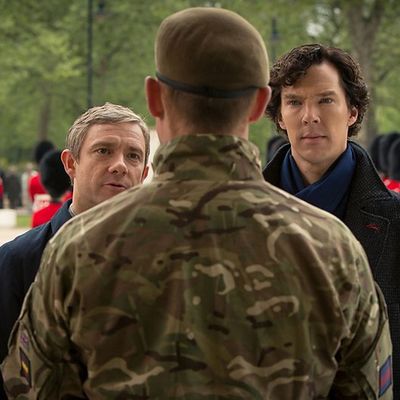
After getting what was an admittedly tricky resurrection and/or reunion out of the way the last time out, you might have expected this week’s installment, “The Sign of Three,” to get back to the serious business of solving crimes. Instead, Sherlock’s sophomore season-three outing continued on its path to something bordering on sitcom, with a wedding-themed episode that looked more like a Richard Curtis rom-com than a case-cracking caper.
Not that that’s necessarily a bad thing, of course. In the comments section of last week’s recap, many of you were fully onboard with the development of Benedict Cumberbatch’s character, a transformation that continued apace this week when he took up best-man duties at Watson’s wedding. It’s a role that Sherlock himself described as “the hardest thing I’ve ever had to do in my life,” and it’s difficult to disagree with him. In fact, the episode opens with a comic cry for help in which Lestrade rushes to Holmes’s aid after receiving a string of desperate texts from the consulting detective — texts that would later turn out to be pleas for assistance with his speech.
It’s a sequence that once again shows just how important Sherlock has become to those around him, as his friend on the force gives up what might have been the collar of his career in order to come to Holmes’s aid. However, it also shows just how ill-equipped he is for such relationships, as Lestrade turns up with half of Scotland Yard in tow after mistaking the consulting detective’s urgency for imminent danger. Communication, it seems, isn’t Sherlock’s strongest suit — though, in his defense, Lestrade could have at least texted him back before calling for backup.
Indeed, Lestrade isn’t the only character who’s concerned about Sherlock this week. Mrs. Hudson — played brilliantly by Una Stubbs — picks up the baton with an anecdote on how marriage inevitably changes people. While her racy reminiscences about a life spent as the better half of a drug lord are clearly played for laughs, it’s hard to avoid the fact that Mrs. H is voicing what Sherlock, and indeed the audience, fear might happen once Watson has wed. Later on we’ll also see Molly, Watson, and even Mary — more on her later — looking out for the socially maladjusted sleuth as the big day approaches.
And what of the big day? Well, the wedding is pure unadulterated Sherlock. A happy occasion made up of bullet-time photo shoots, time-lapse feasts, and all manner of onscreen graphics. It’s all part of an installment that does a superb job of visualizing Sherlock’s deductive process, something that, for this writer anyway, sets the series apart from previous attempts to adapt Sir Arthur Conan Doyle’s work. The happy occasion, like the rest of the episode, is crammed full of comedy — there are probably more funny bits strewn throughout “The Sign of Three” than in the previous seven outings combined, another example of how Sherlock seems to be slowly transforming from a detective show into a show that just happens to have a detective as its principal character.
Amid all the punch lines, however, there’s also plenty of pathos, almost all of it wrapped up in Sherlock’s truly extraordinary speech: a tear-jerking toast that has to go down as one of the small screen’s best moments of the year. (I’m pretty sure I had something in my eye at one point, anyway.) It offered a great summation of what makes this particular Holmes-Watson relationship tick, but it also did a fine job of establishing Mary as a central part of Sherlock’s future.
As flashbacks to the wedding planning show, Sherlock clearly has plenty of affection for the future Mrs. Watson. The sequences also painted Mary as that rare thing: a character who can stand up to the cantankerous crime solver. While the show has been met with near universal acclaim during its run to date, Sherlock has come in for criticism in some quarters for its lack of genuine gender balance; fortunately, it seems it’s something that the writers are finally addressing with Mary, a character who after just two episodes already feels like part of the furniture.
Sherlock’s speech also set up this week’s case, a three-part caper involving a dishonored army officer, a delayed stabbing, and a tight-fitting belt. The three cases, as it turned out, all proved to be part of the same attempted murder — an elaborate and enjoyable plot that perhaps deserved more screen time than it was afforded.
I shouldn’t go any further without mentioning the bachelor party. Despite meticulous planning to prevent such an eventuality, the murder-themed pub crawl ensured that we were treated to the sight of an inebriated Sherlock, a drunken detective who fought over ash, boasted about his “international reputation,” and compromised a crime scene in the most disgusting manner possible. It made for hilarious viewing and rewarded eagle-eyed armchair dwellers, particularly the blink-and-you’ll-miss-them details, like my personal favorite: Sherlock’s “sitty thing” deduction.
Attempted murders solved, Mayfly man caught, and speech suitably nailed, there was just time at the end of the episode for one final revelation; Sherlock inadvertently reveals that Mary is pregnant (with a nice callback to the episode’s title). It’s a game changer for the show and for Holmes, who was once again left alone by the episode’s conclusion.
All in all, “The Sign of Three” was a zippy, heartfelt upgrade on last week’s adventure. However, it’s hard to avoid saying that it perhaps tried to do too much. Of course, that’s partly a symptom of the show’s format; unlike the majority of dramas, Sherlock has just three episodes a season to play with, a few short hours into which it must squeeze a smorgasbord of story lines that a typical show could play out over weeks and months. It’s part of what makes Sherlock such a rarefied vintage, of course. Indeed, with the flashbacks to previous cases — particularly the riddle of the French decathlete — the writers were almost teasing us over what the show might become were it reduced to a “freak of the week” format. Clearly, everyone involved believes that less is more when it comes to this particular adaptation. But perhaps it’s time that they started to take their own advice when it comes to scribbling future episodes?
CASE NOTES
The Sign of Four: The episode is of course a play on “The Sign of Four,” Sherlock Holmes’s sophomore adventure and the story in which the literary version of John Watson meets Mary Morstan.
Major Sholto and Jonathan Small: Both Sholto and Small are characters that appear in Sir Arthur Conan Doyle’s original story.
The Poison Giant: The flashback to the case of “The Poison Giant” in Sherlock’s speech is another canonical reference — a blowpipe-wielding pygmy being a prominent character in “The Sign of Four” story.
The Inexplicable Matchbox: There’s no equivalent in the original stories for this particular case; however, a quick look on John Watson’s blog teases that the investigation involved Sherlock disguised as a clown and Mrs. Hudson being pushed out of a helicopter
The Bloody Guardsmen: Seems to be a loose reference to “The Adventure of the Crooked Man,” another locked-door mystery involving a soldier and an army camp.
Cigarettes and slippers: Congratulations to viewers who spotted Sherlock stowing his cigarettes in a Persian slipper, the same place his literary counterpart used to stash his supply of Shag tobacco.
The telegrams: There were a couple of neat references dotted in among the wedding telegrams. One was from Mike Stamford, who introduces the detecting duo in “A Study in Pink.” There’s also a mysterious note from a character named CAM, which just happen to be the initials of Charles Augustus Milverton, a blackmailer who appears in one of Conan Doyle’s short stories.
DEDUCTIONS
What or who is Redbeard?
Sherlock’s expression notably darkened after Mycroft bought up the apparently thorny subject of Redbeard. But what or who is it?
The woman?
Good to see Laura Pulver return as Irene Adler, if only for a fleeting moment. Do we think this is merely a tip of the deerstalker to fans or a sign of her impending return?
Sherlock love interest?
Was it just me, or was there a spark between Sherlock and Janine?
What happened to last week’s big bad?
After a brief glimpse at the end of last week’s episode, the menacing figure who seemed to be set up as season three’s big bad was conspicuous by his absence in “The Sign of Three.” Or was he?
Let us know your thoughts on this week’s episode below, or share your deductions with me via Twitter.




